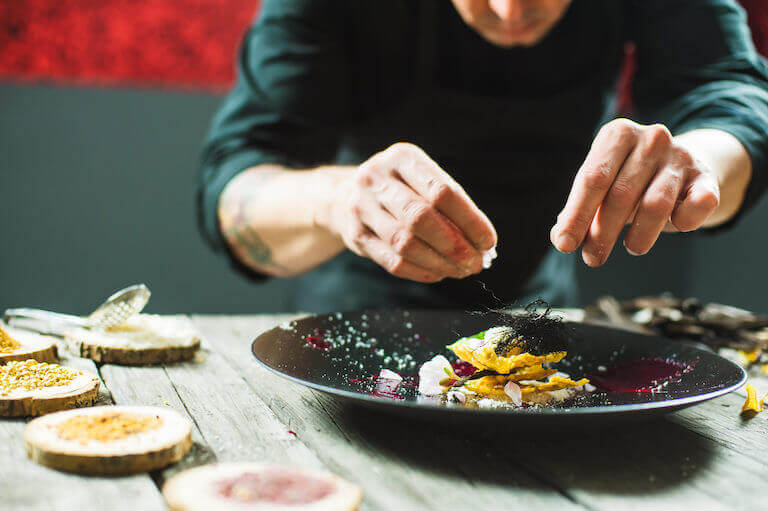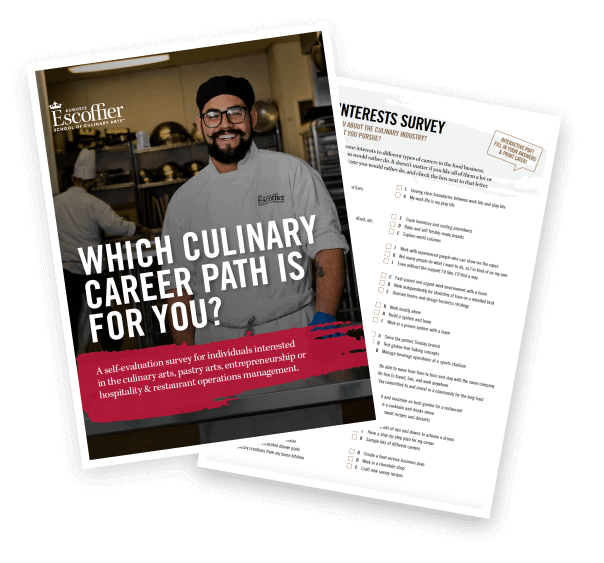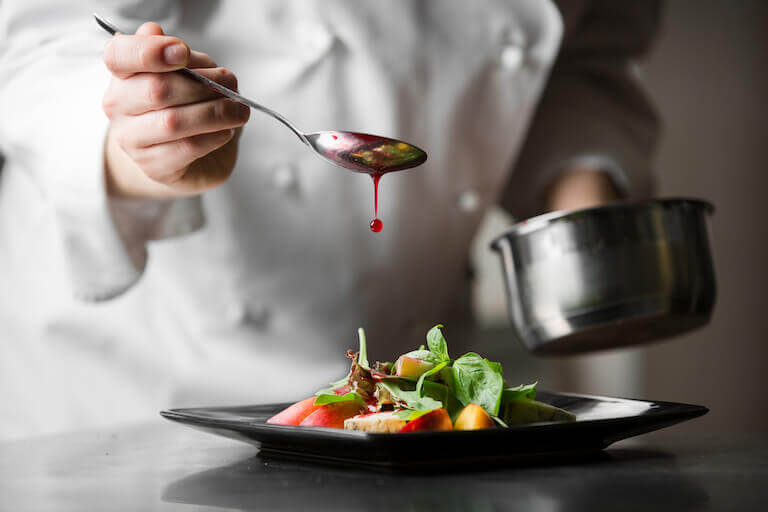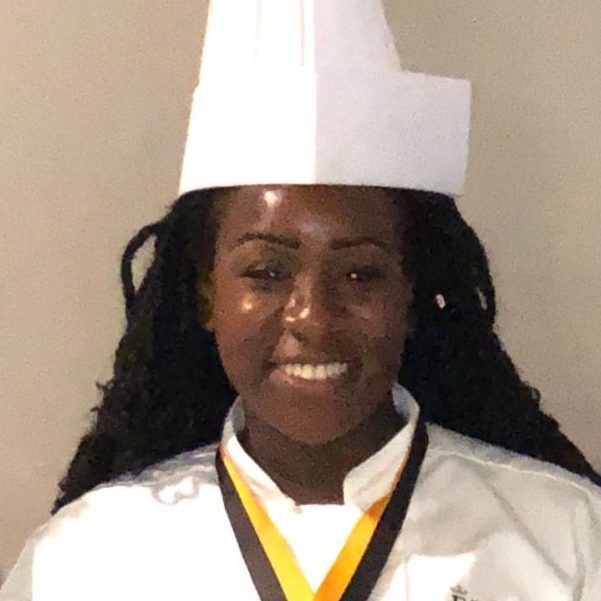Listen to This Article:
Everyone—from the home cook to the professional chef—has been there: you sample your almost-completed dish and find something is lacking. The balance just isn’t quite right.
Amateur culinarians can feel stuck, unsure of what to do next.
But cooks and chefs who understand flavor profiles may know exactly what to do.
Maybe you need to add a little more salt. Perhaps a touch of acidity will brighten the flavors. Or the dish might want a bit of rich umami—a sprinkling of nutty, sharp parmesan cheese, or a splash of tangy Worcestershire sauce.
Understanding flavor is key to creating balanced and exciting dishes, and can be the difference between whether your food elicits a “WOW!” or a “meh” from your guests.
Let’s take a closer look at flavor, the way Escoffier’s Culinary Arts students dive deep into flavor profiles—and why it matters in your culinary career.
The Parts of the Flavor Profile
When we talk about flavor, we’re talking about much more than just taste (although that’s an important component!)
What we’re actually talking about is a trifecta of taste, aroma, and mouthfeel. These three factors combine to create the total experience of a dish—in other words, the dish’s flavor profile.
So, what are each of these components?
Taste
“Taste” may be what comes to mind first when we think about flavor. There are five primary tastes:
- Salty (such as cheeses, sea salt/kosher salt, or soy sauce)
- Sweet (such as sugar, maple syrup, sweet potatoes, or beets)
- Sour (such as citrus, vinegars, yogurt, or pickled veggies)
- Bitter (such as coffee, grapefruit, beer, or bitter greens like kale and radicchio)
- Umami (a loanword from Japanese that roughly translates to “pleasant savoriness,” this taste is found in foods such as bacon, cured meats, fish sauce, or seaweed)
The balance of these flavors affects what we taste in unexpected ways. For example, acidity makes you salivate, which helps distribute flavors throughout your mouth, landing on more of your taste buds. That’s why a little acidity—a small squeeze of lemon, a splash of vinegar—can really open up the flavor of a dish.
Salt is another taste that enhances the flavors of just about everything, from umami to sweet. A caramel with a bit of salt on top will actually taste sweeter because of the added salt.

That final pinch of salt can make all the difference to the flavor profile of your dish.
The prevailing wisdom used to be that different parts of our tongue registered different tastes. Sweet flavors registered on the front of the tongue, bitter on the back, and sour and salty in the middle. But we now know that taste buds are spread all over the tongue, and they can all register all the flavors.
Aroma
Aroma, or smell, is a major part of what we taste. Flowery, nutty, or spicy smells create an important part of the overall eating experience. In fact, aroma may play a dominant role in our experience of flavor, and food can even seem to taste bland if you’re not able to smell it.
As an example of the powerful effects of aroma, consider vanilla extract. Many of us begged our parents to let us taste that wonderful-smelling liquid when we were kids. But when we did, we were in for a nasty surprise. On its own, it tastes terrible. But when a tiny amount of that potent aroma is added to desserts, it enhances both the flavor and the smell of the baked dish.
Mouthfeel
An unpleasant texture can make a dish go from delightful to disgusting. Grainy sauces, tough meat, and watery soups all can ruin the overall flavor of the dish.
The texture and mouthfeel can actually be a major component in how we identify foods! One study showed that young adults of normal weight could only identify about 40% of foods when they’d been pureed and strained.
How Culinary Students Experiment with Flavor Profiles
Flavor is a highly nuanced phenomenon that depends on a wide variety of factors combining in unique ways—and there is no simple recipe for mastering the balance of tastes, aromas, and textures involved in cooking. Instead, this knowledge will generally only grow through experience, which is exactly how students tackle flavor profiles as they progress through their courses at Escoffier.
The key is experimentation. No matter how much experience you have, there will be some trial and error. But that’s one of the benefits of culinary school. Students have access to their Chef Instructors, who hold a wealth of knowledge about flavor combinations and relationships and can provide advice and direction on how students can improve.
Students are able to explore flavor throughout many parts of the Escoffier curriculum. Menu and recipe development, world cuisines, and the Farm To Table® Experience are all closely connected to the way we experience flavor.
One of the key tools students can use to help translate what they’re tasting into words is the Escoffier Flavor Wheel. Both on-campus and online students must be able to explain what they’re tasting to their Chef Instructors, so that they can receive feedback. While on-campus students may be reporting to their Chef Instructors verbally, online students include their flavor and tasting notes in written summaries of their projects.

Take the Culinary Career Survey
We’ve compiled a checklist of all of the essential questions into one handy tool: career options, culinary interest surveys, educational opportunities, and more.
The Flavor Wheel breaks down the basic flavor components into more specific tastes, aromas, and textures. Is a sour flavor tangy or acrid? Is a fruity aroma citrusy or berry-like? This shared vocabulary helps students to communicate with their in-person or online Chef Instructors, so that they can hone in on what worked and what needs to be adjusted.
This can be particularly helpful as students explore how flavor balances are approached in different world cuisines. Thai tom kha gai soup, for example, has a wonderful flavor profile of umami (from mushrooms and fish sauce), sour (from lime and lemongrass), and sweet (from a touch of sugar). It has a fresh aroma from cilantro, and a rich texture from coconut milk.
When trying new cuisines, the Flavor Wheel can help put new tastes and aromas into terms that students are more familiar with.
Flavor also ties into the seasonality of foods, which is discussed during the six-week Farm To Table® Experience. Fresher produce will have stronger—and often sweeter—flavor. Understanding what’s in season can help students to plan menus, and to be prepared to tweak recipes. For example, if you’re making a gazpacho outside of tomato season, you may need to add more seasoning to compensate for less flavorful tomatoes.
Understanding Flavor Profiles Can Help Your Career
As a culinary professional, a strong understanding of flavor is everything. Whether or not you thoroughly understand how to create and manipulate flavors can be the difference between whether a guest recommends your restaurant to all their friends, or never comes back again. It’s also vital that you’re able to communicate about flavor to other staff in the kitchen, so that everyone involved is able to prepare your dishes to the same high standard.

A professional chef should be able to create flavorful dishes, and prepare them the same way every time.
Understanding flavor profiles is important in other culinary professions, too. For example, a food critic must be able to write about the nuances of all the dishes they try, while a food influencer should know how to talk about them in a way their audience will find engaging. If you’re a recipe developer, you’ll likely spend most of your days tinkering with tiny details of flavor profiles in order to create just the right combination.
And no matter what food career you may be in, a strong understanding of flavor will help you keep up with food trends, which can help you stay current with changes in the culinary industry.
Flavor Is Everywhere!
Once culinarians understand the basics of flavor profiles, they can start to understand why certain combinations work—from the classic sweet-and-salty peanut butter and jelly to the complex tom kha gai.
You don’t have to attend culinary school to start experimenting with flavor. But if you want to dive deep—and especially if you’re considering a culinary career—pursuing a degree or diploma at Escoffier’s campuses in Austin or Boulder, or through online culinary school, can be a great place to start!
IF YOU FOUND THAT ARTICLE INTERESTING, HERE ARE A FEW MORE YOU MAY LIKE:
- World’s Most Expensive Foods: 10 of the Priciest Ingredients on the Planet
- Five Culinary Skills You Can Take With You Wherever You Go
- Knife Skills Classes: 8 Knife Cuts Every Professional Cook Should Know
*Information may not reflect every student’s experience. Results and outcomes may be based on several factors, such as geographical region or previous experience.



